Professional Skills: 3D Printing Technology in Organizations
VerifiedAdded on 2023/06/12
|13
|3457
|199
Report
AI Summary
This report examines 3D printing technology and its potential integration into an organization specializing in printers and PCs. The organization aims to expand globally, particularly to the United States and Australia, cost-effectively and without significant infrastructure investments. The report evaluates 3D printing, its applications across industries like customized shoes, circuit planning, and aerospace, and its current use in manufacturing and medical fields. It proposes three 3D printing-based applications for the organization, including using Nano Dimension's technology for small electronics planning, standardizing PCB sheet production, and creating model prototypes. The report discusses the advantages (faster item planning, cost reduction, advanced customization) and disadvantages (slowdown of certain advancements, high energy consumption, high initial costs, limited access to raw materials) of these applications. It also explores the ethical, social, and legal considerations, including the moral implications of funding for R&D purposes. The report concludes with recommendations for preventing potential issues and leveraging the benefits of 3D printing technology.
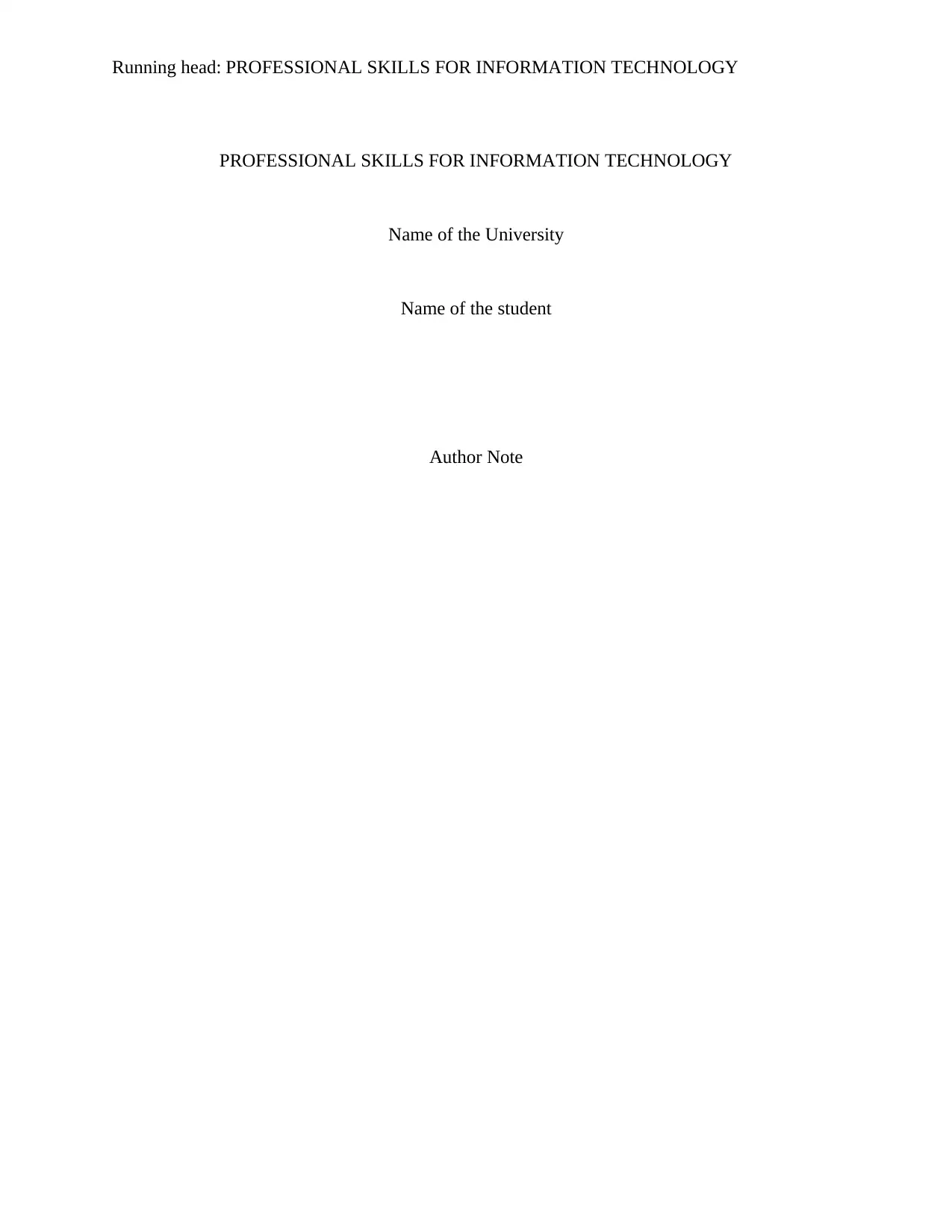
Running head: PROFESSIONAL SKILLS FOR INFORMATION TECHNOLOGY
PROFESSIONAL SKILLS FOR INFORMATION TECHNOLOGY
Name of the University
Name of the student
Author Note
PROFESSIONAL SKILLS FOR INFORMATION TECHNOLOGY
Name of the University
Name of the student
Author Note
Secure Best Marks with AI Grader
Need help grading? Try our AI Grader for instant feedback on your assignments.
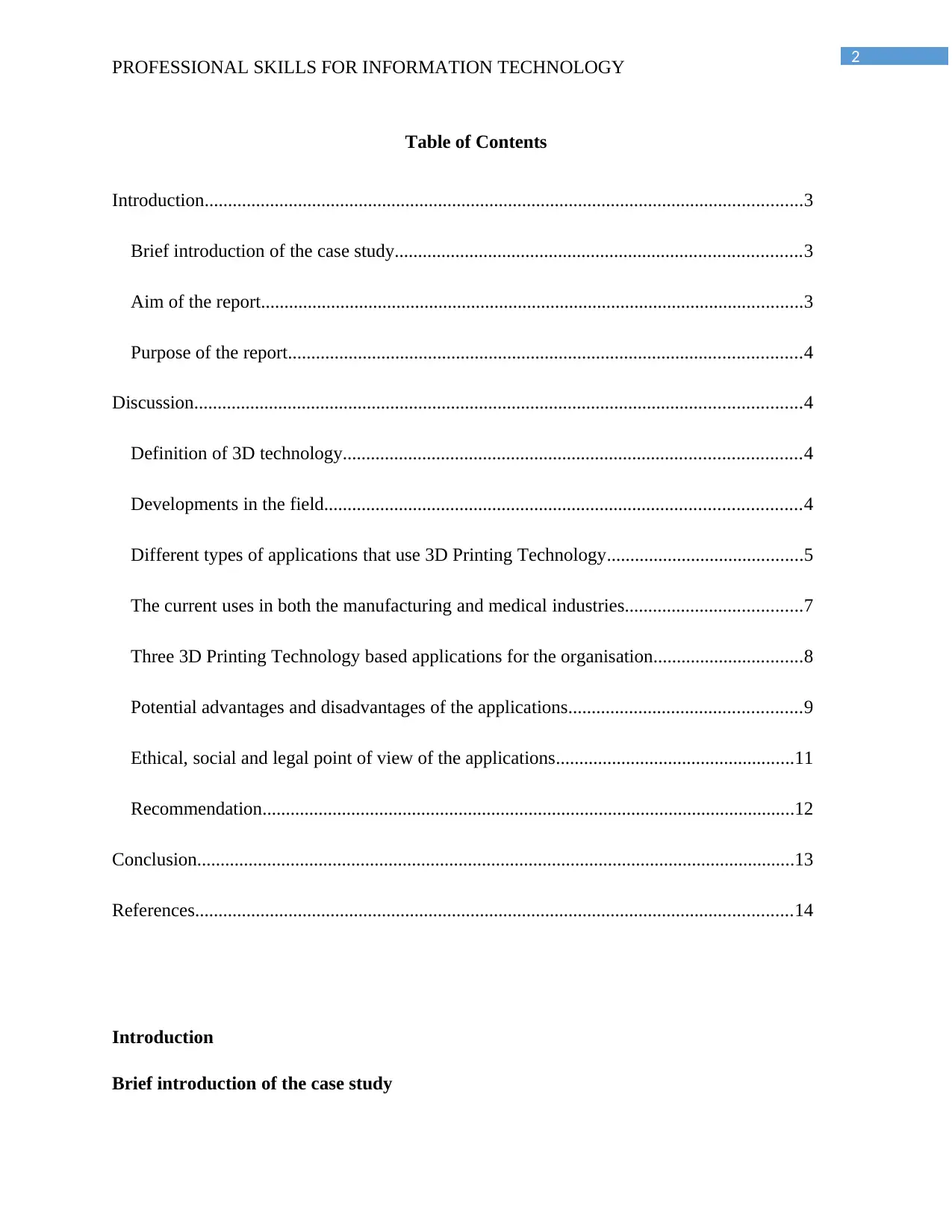
2
PROFESSIONAL SKILLS FOR INFORMATION TECHNOLOGY
Table of Contents
Introduction................................................................................................................................3
Brief introduction of the case study.......................................................................................3
Aim of the report....................................................................................................................3
Purpose of the report..............................................................................................................4
Discussion..................................................................................................................................4
Definition of 3D technology..................................................................................................4
Developments in the field......................................................................................................4
Different types of applications that use 3D Printing Technology..........................................5
The current uses in both the manufacturing and medical industries......................................7
Three 3D Printing Technology based applications for the organisation................................8
Potential advantages and disadvantages of the applications..................................................9
Ethical, social and legal point of view of the applications...................................................11
Recommendation..................................................................................................................12
Conclusion................................................................................................................................13
References................................................................................................................................14
Introduction
Brief introduction of the case study
PROFESSIONAL SKILLS FOR INFORMATION TECHNOLOGY
Table of Contents
Introduction................................................................................................................................3
Brief introduction of the case study.......................................................................................3
Aim of the report....................................................................................................................3
Purpose of the report..............................................................................................................4
Discussion..................................................................................................................................4
Definition of 3D technology..................................................................................................4
Developments in the field......................................................................................................4
Different types of applications that use 3D Printing Technology..........................................5
The current uses in both the manufacturing and medical industries......................................7
Three 3D Printing Technology based applications for the organisation................................8
Potential advantages and disadvantages of the applications..................................................9
Ethical, social and legal point of view of the applications...................................................11
Recommendation..................................................................................................................12
Conclusion................................................................................................................................13
References................................................................................................................................14
Introduction
Brief introduction of the case study
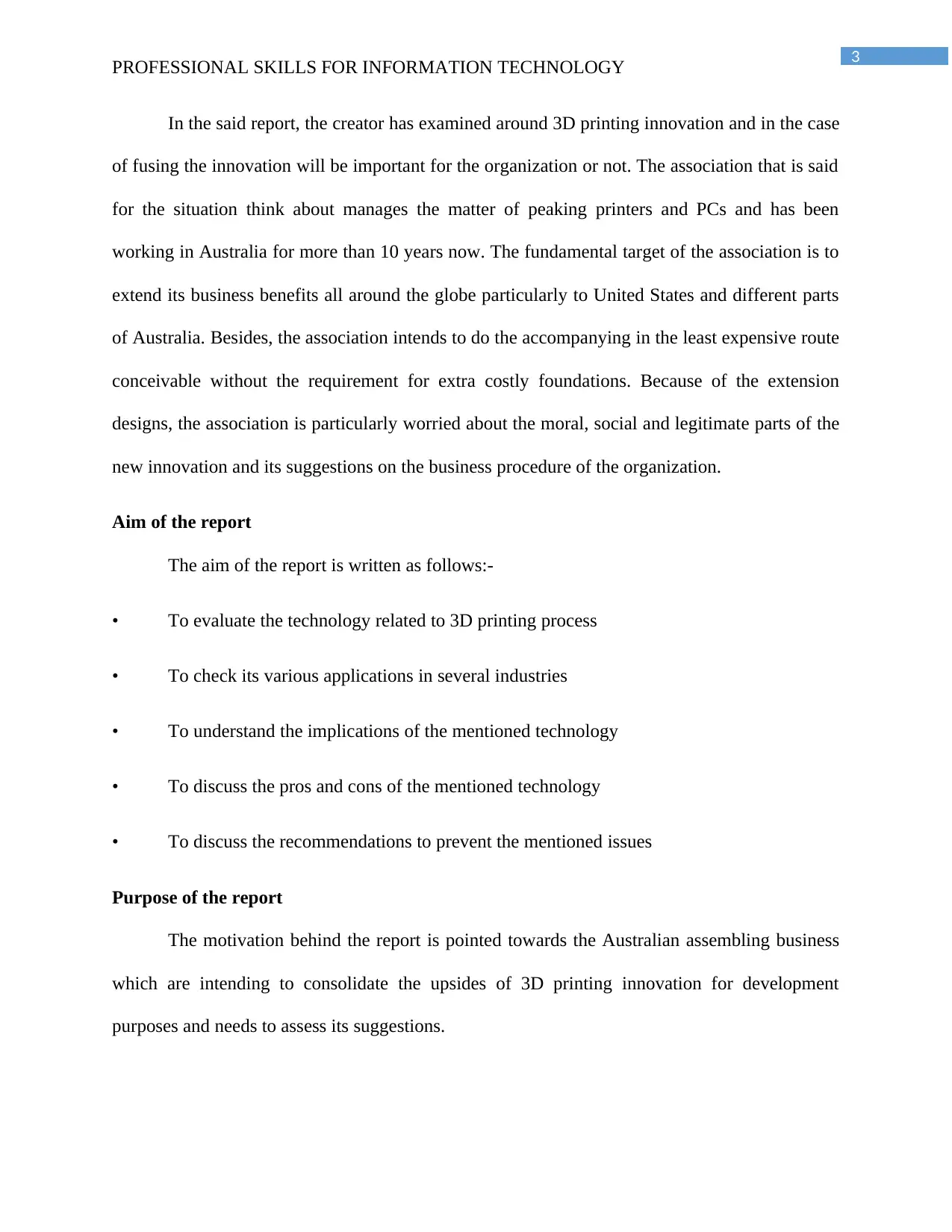
3
PROFESSIONAL SKILLS FOR INFORMATION TECHNOLOGY
In the said report, the creator has examined around 3D printing innovation and in the case
of fusing the innovation will be important for the organization or not. The association that is said
for the situation think about manages the matter of peaking printers and PCs and has been
working in Australia for more than 10 years now. The fundamental target of the association is to
extend its business benefits all around the globe particularly to United States and different parts
of Australia. Besides, the association intends to do the accompanying in the least expensive route
conceivable without the requirement for extra costly foundations. Because of the extension
designs, the association is particularly worried about the moral, social and legitimate parts of the
new innovation and its suggestions on the business procedure of the organization.
Aim of the report
The aim of the report is written as follows:-
• To evaluate the technology related to 3D printing process
• To check its various applications in several industries
• To understand the implications of the mentioned technology
• To discuss the pros and cons of the mentioned technology
• To discuss the recommendations to prevent the mentioned issues
Purpose of the report
The motivation behind the report is pointed towards the Australian assembling business
which are intending to consolidate the upsides of 3D printing innovation for development
purposes and needs to assess its suggestions.
PROFESSIONAL SKILLS FOR INFORMATION TECHNOLOGY
In the said report, the creator has examined around 3D printing innovation and in the case
of fusing the innovation will be important for the organization or not. The association that is said
for the situation think about manages the matter of peaking printers and PCs and has been
working in Australia for more than 10 years now. The fundamental target of the association is to
extend its business benefits all around the globe particularly to United States and different parts
of Australia. Besides, the association intends to do the accompanying in the least expensive route
conceivable without the requirement for extra costly foundations. Because of the extension
designs, the association is particularly worried about the moral, social and legitimate parts of the
new innovation and its suggestions on the business procedure of the organization.
Aim of the report
The aim of the report is written as follows:-
• To evaluate the technology related to 3D printing process
• To check its various applications in several industries
• To understand the implications of the mentioned technology
• To discuss the pros and cons of the mentioned technology
• To discuss the recommendations to prevent the mentioned issues
Purpose of the report
The motivation behind the report is pointed towards the Australian assembling business
which are intending to consolidate the upsides of 3D printing innovation for development
purposes and needs to assess its suggestions.
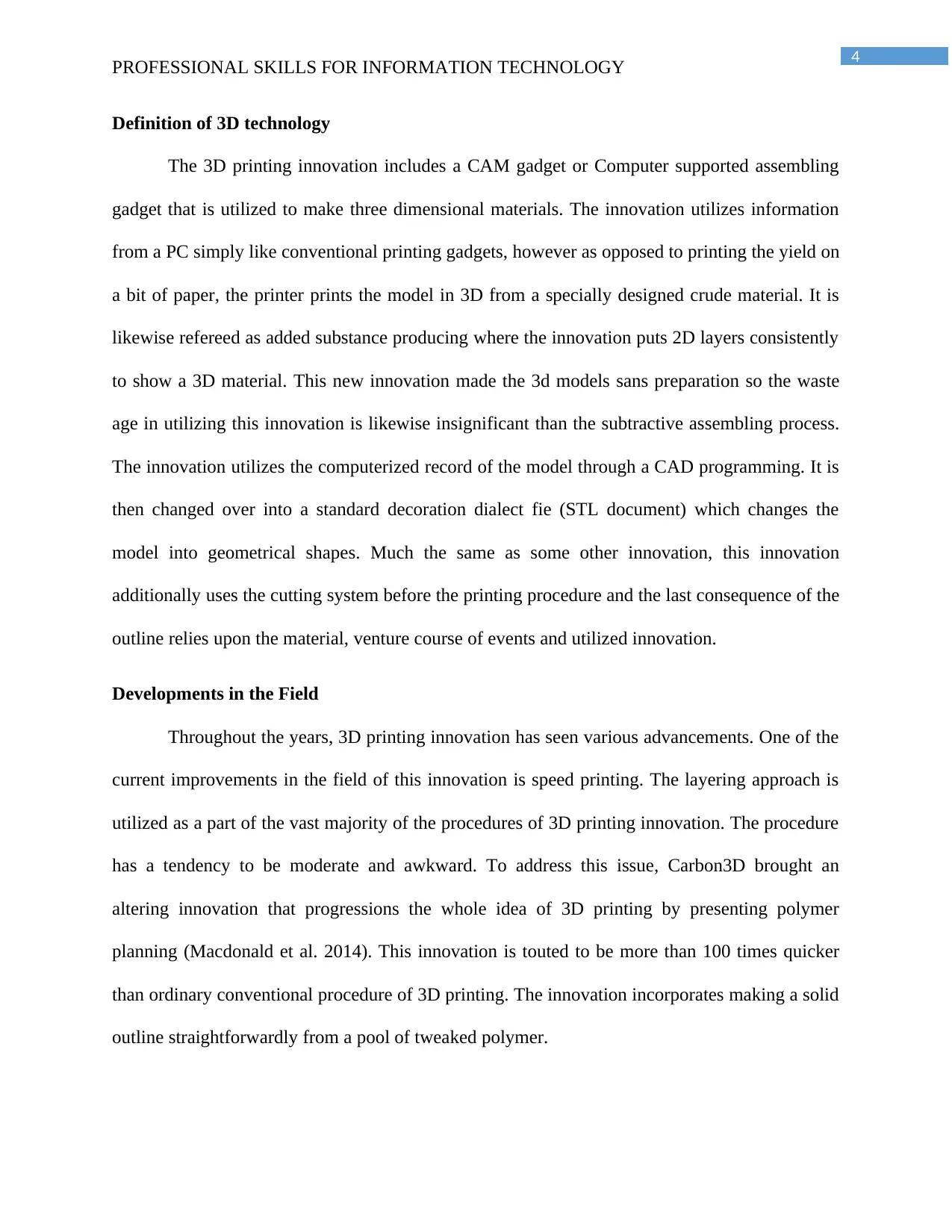
4
PROFESSIONAL SKILLS FOR INFORMATION TECHNOLOGY
Definition of 3D technology
The 3D printing innovation includes a CAM gadget or Computer supported assembling
gadget that is utilized to make three dimensional materials. The innovation utilizes information
from a PC simply like conventional printing gadgets, however as opposed to printing the yield on
a bit of paper, the printer prints the model in 3D from a specially designed crude material. It is
likewise refereed as added substance producing where the innovation puts 2D layers consistently
to show a 3D material. This new innovation made the 3d models sans preparation so the waste
age in utilizing this innovation is likewise insignificant than the subtractive assembling process.
The innovation utilizes the computerized record of the model through a CAD programming. It is
then changed over into a standard decoration dialect fie (STL document) which changes the
model into geometrical shapes. Much the same as some other innovation, this innovation
additionally uses the cutting system before the printing procedure and the last consequence of the
outline relies upon the material, venture course of events and utilized innovation.
Developments in the Field
Throughout the years, 3D printing innovation has seen various advancements. One of the
current improvements in the field of this innovation is speed printing. The layering approach is
utilized as a part of the vast majority of the procedures of 3D printing innovation. The procedure
has a tendency to be moderate and awkward. To address this issue, Carbon3D brought an
altering innovation that progressions the whole idea of 3D printing by presenting polymer
planning (Macdonald et al. 2014). This innovation is touted to be more than 100 times quicker
than ordinary conventional procedure of 3D printing. The innovation incorporates making a solid
outline straightforwardly from a pool of tweaked polymer.
PROFESSIONAL SKILLS FOR INFORMATION TECHNOLOGY
Definition of 3D technology
The 3D printing innovation includes a CAM gadget or Computer supported assembling
gadget that is utilized to make three dimensional materials. The innovation utilizes information
from a PC simply like conventional printing gadgets, however as opposed to printing the yield on
a bit of paper, the printer prints the model in 3D from a specially designed crude material. It is
likewise refereed as added substance producing where the innovation puts 2D layers consistently
to show a 3D material. This new innovation made the 3d models sans preparation so the waste
age in utilizing this innovation is likewise insignificant than the subtractive assembling process.
The innovation utilizes the computerized record of the model through a CAD programming. It is
then changed over into a standard decoration dialect fie (STL document) which changes the
model into geometrical shapes. Much the same as some other innovation, this innovation
additionally uses the cutting system before the printing procedure and the last consequence of the
outline relies upon the material, venture course of events and utilized innovation.
Developments in the Field
Throughout the years, 3D printing innovation has seen various advancements. One of the
current improvements in the field of this innovation is speed printing. The layering approach is
utilized as a part of the vast majority of the procedures of 3D printing innovation. The procedure
has a tendency to be moderate and awkward. To address this issue, Carbon3D brought an
altering innovation that progressions the whole idea of 3D printing by presenting polymer
planning (Macdonald et al. 2014). This innovation is touted to be more than 100 times quicker
than ordinary conventional procedure of 3D printing. The innovation incorporates making a solid
outline straightforwardly from a pool of tweaked polymer.
Secure Best Marks with AI Grader
Need help grading? Try our AI Grader for instant feedback on your assignments.
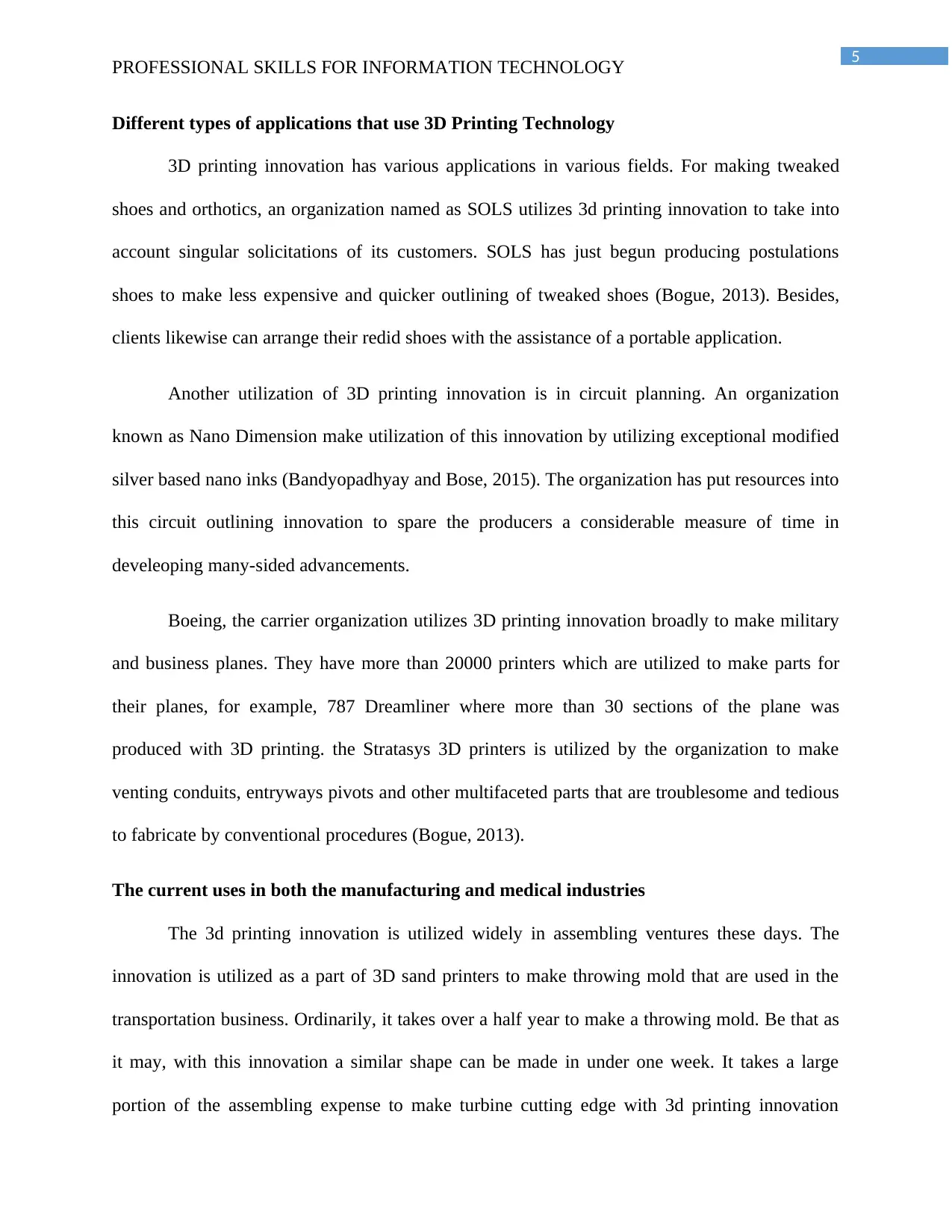
5
PROFESSIONAL SKILLS FOR INFORMATION TECHNOLOGY
Different types of applications that use 3D Printing Technology
3D printing innovation has various applications in various fields. For making tweaked
shoes and orthotics, an organization named as SOLS utilizes 3d printing innovation to take into
account singular solicitations of its customers. SOLS has just begun producing postulations
shoes to make less expensive and quicker outlining of tweaked shoes (Bogue, 2013). Besides,
clients likewise can arrange their redid shoes with the assistance of a portable application.
Another utilization of 3D printing innovation is in circuit planning. An organization
known as Nano Dimension make utilization of this innovation by utilizing exceptional modified
silver based nano inks (Bandyopadhyay and Bose, 2015). The organization has put resources into
this circuit outlining innovation to spare the producers a considerable measure of time in
develeoping many-sided advancements.
Boeing, the carrier organization utilizes 3D printing innovation broadly to make military
and business planes. They have more than 20000 printers which are utilized to make parts for
their planes, for example, 787 Dreamliner where more than 30 sections of the plane was
produced with 3D printing. the Stratasys 3D printers is utilized by the organization to make
venting conduits, entryways pivots and other multifaceted parts that are troublesome and tedious
to fabricate by conventional procedures (Bogue, 2013).
The current uses in both the manufacturing and medical industries
The 3d printing innovation is utilized widely in assembling ventures these days. The
innovation is utilized as a part of 3D sand printers to make throwing mold that are used in the
transportation business. Ordinarily, it takes over a half year to make a throwing mold. Be that as
it may, with this innovation a similar shape can be made in under one week. It takes a large
portion of the assembling expense to make turbine cutting edge with 3d printing innovation
PROFESSIONAL SKILLS FOR INFORMATION TECHNOLOGY
Different types of applications that use 3D Printing Technology
3D printing innovation has various applications in various fields. For making tweaked
shoes and orthotics, an organization named as SOLS utilizes 3d printing innovation to take into
account singular solicitations of its customers. SOLS has just begun producing postulations
shoes to make less expensive and quicker outlining of tweaked shoes (Bogue, 2013). Besides,
clients likewise can arrange their redid shoes with the assistance of a portable application.
Another utilization of 3D printing innovation is in circuit planning. An organization
known as Nano Dimension make utilization of this innovation by utilizing exceptional modified
silver based nano inks (Bandyopadhyay and Bose, 2015). The organization has put resources into
this circuit outlining innovation to spare the producers a considerable measure of time in
develeoping many-sided advancements.
Boeing, the carrier organization utilizes 3D printing innovation broadly to make military
and business planes. They have more than 20000 printers which are utilized to make parts for
their planes, for example, 787 Dreamliner where more than 30 sections of the plane was
produced with 3D printing. the Stratasys 3D printers is utilized by the organization to make
venting conduits, entryways pivots and other multifaceted parts that are troublesome and tedious
to fabricate by conventional procedures (Bogue, 2013).
The current uses in both the manufacturing and medical industries
The 3d printing innovation is utilized widely in assembling ventures these days. The
innovation is utilized as a part of 3D sand printers to make throwing mold that are used in the
transportation business. Ordinarily, it takes over a half year to make a throwing mold. Be that as
it may, with this innovation a similar shape can be made in under one week. It takes a large
portion of the assembling expense to make turbine cutting edge with 3d printing innovation
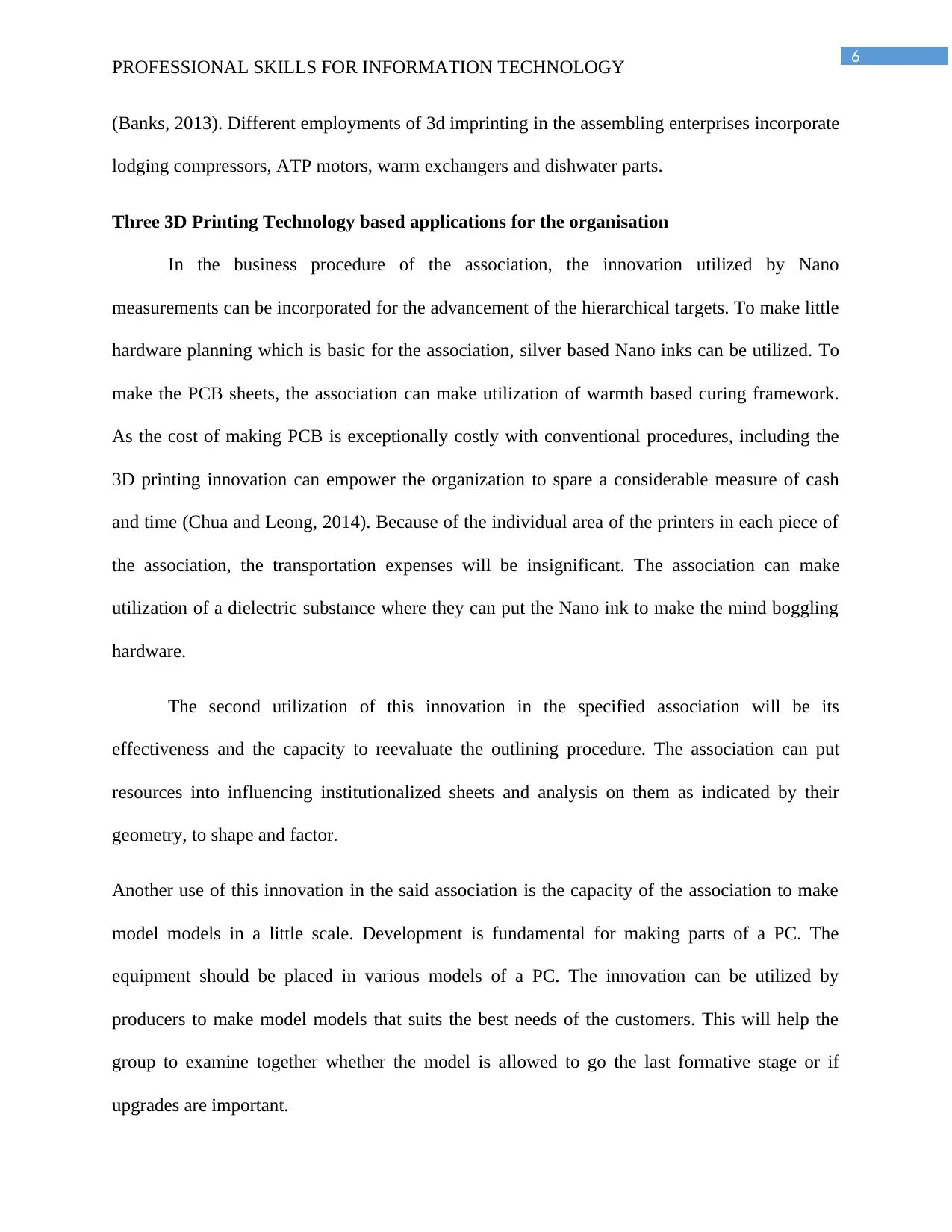
6
PROFESSIONAL SKILLS FOR INFORMATION TECHNOLOGY
(Banks, 2013). Different employments of 3d imprinting in the assembling enterprises incorporate
lodging compressors, ATP motors, warm exchangers and dishwater parts.
Three 3D Printing Technology based applications for the organisation
In the business procedure of the association, the innovation utilized by Nano
measurements can be incorporated for the advancement of the hierarchical targets. To make little
hardware planning which is basic for the association, silver based Nano inks can be utilized. To
make the PCB sheets, the association can make utilization of warmth based curing framework.
As the cost of making PCB is exceptionally costly with conventional procedures, including the
3D printing innovation can empower the organization to spare a considerable measure of cash
and time (Chua and Leong, 2014). Because of the individual area of the printers in each piece of
the association, the transportation expenses will be insignificant. The association can make
utilization of a dielectric substance where they can put the Nano ink to make the mind boggling
hardware.
The second utilization of this innovation in the specified association will be its
effectiveness and the capacity to reevaluate the outlining procedure. The association can put
resources into influencing institutionalized sheets and analysis on them as indicated by their
geometry, to shape and factor.
Another use of this innovation in the said association is the capacity of the association to make
model models in a little scale. Development is fundamental for making parts of a PC. The
equipment should be placed in various models of a PC. The innovation can be utilized by
producers to make model models that suits the best needs of the customers. This will help the
group to examine together whether the model is allowed to go the last formative stage or if
upgrades are important.
PROFESSIONAL SKILLS FOR INFORMATION TECHNOLOGY
(Banks, 2013). Different employments of 3d imprinting in the assembling enterprises incorporate
lodging compressors, ATP motors, warm exchangers and dishwater parts.
Three 3D Printing Technology based applications for the organisation
In the business procedure of the association, the innovation utilized by Nano
measurements can be incorporated for the advancement of the hierarchical targets. To make little
hardware planning which is basic for the association, silver based Nano inks can be utilized. To
make the PCB sheets, the association can make utilization of warmth based curing framework.
As the cost of making PCB is exceptionally costly with conventional procedures, including the
3D printing innovation can empower the organization to spare a considerable measure of cash
and time (Chua and Leong, 2014). Because of the individual area of the printers in each piece of
the association, the transportation expenses will be insignificant. The association can make
utilization of a dielectric substance where they can put the Nano ink to make the mind boggling
hardware.
The second utilization of this innovation in the specified association will be its
effectiveness and the capacity to reevaluate the outlining procedure. The association can put
resources into influencing institutionalized sheets and analysis on them as indicated by their
geometry, to shape and factor.
Another use of this innovation in the said association is the capacity of the association to make
model models in a little scale. Development is fundamental for making parts of a PC. The
equipment should be placed in various models of a PC. The innovation can be utilized by
producers to make model models that suits the best needs of the customers. This will help the
group to examine together whether the model is allowed to go the last formative stage or if
upgrades are important.
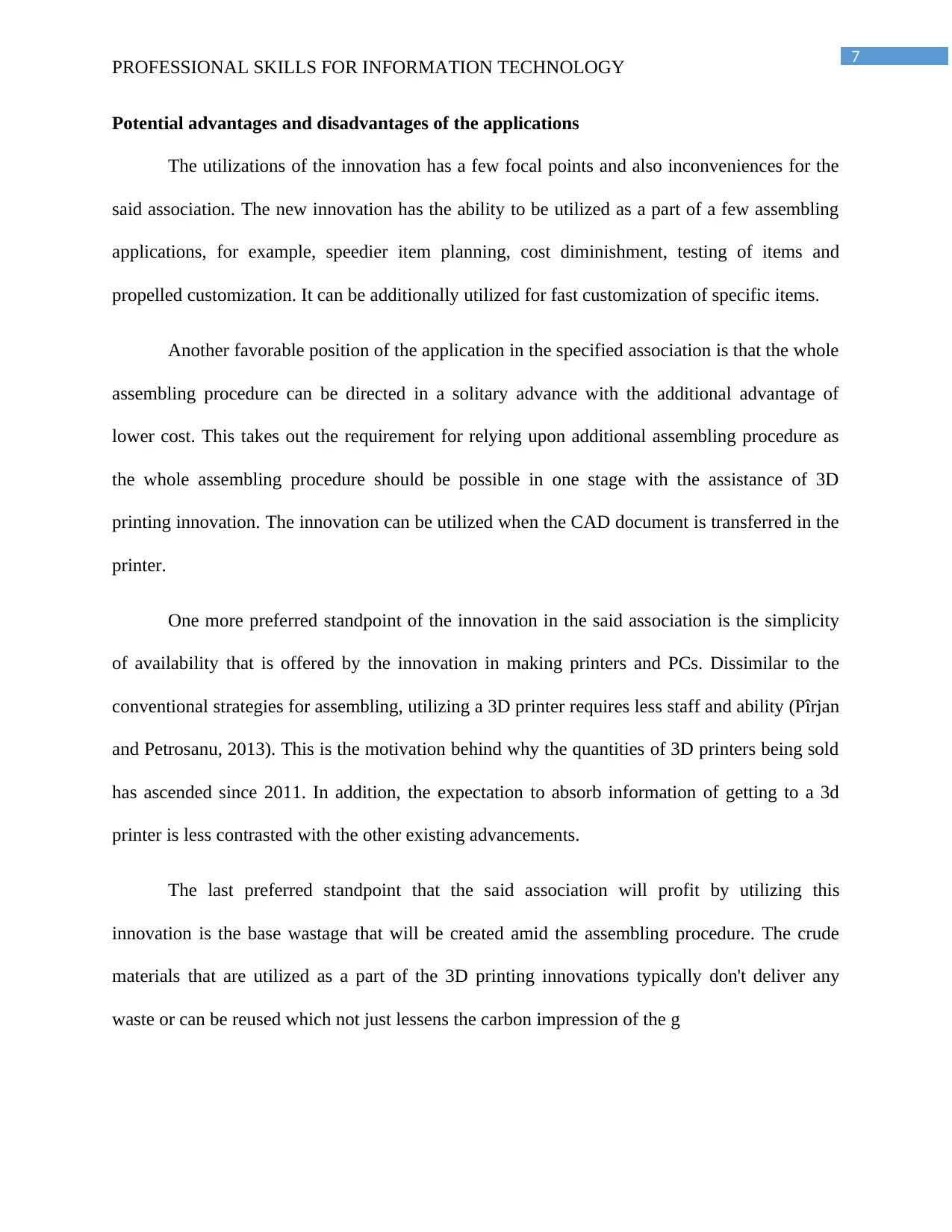
7
PROFESSIONAL SKILLS FOR INFORMATION TECHNOLOGY
Potential advantages and disadvantages of the applications
The utilizations of the innovation has a few focal points and also inconveniences for the
said association. The new innovation has the ability to be utilized as a part of a few assembling
applications, for example, speedier item planning, cost diminishment, testing of items and
propelled customization. It can be additionally utilized for fast customization of specific items.
Another favorable position of the application in the specified association is that the whole
assembling procedure can be directed in a solitary advance with the additional advantage of
lower cost. This takes out the requirement for relying upon additional assembling procedure as
the whole assembling procedure should be possible in one stage with the assistance of 3D
printing innovation. The innovation can be utilized when the CAD document is transferred in the
printer.
One more preferred standpoint of the innovation in the said association is the simplicity
of availability that is offered by the innovation in making printers and PCs. Dissimilar to the
conventional strategies for assembling, utilizing a 3D printer requires less staff and ability (Pîrjan
and Petrosanu, 2013). This is the motivation behind why the quantities of 3D printers being sold
has ascended since 2011. In addition, the expectation to absorb information of getting to a 3d
printer is less contrasted with the other existing advancements.
The last preferred standpoint that the said association will profit by utilizing this
innovation is the base wastage that will be created amid the assembling procedure. The crude
materials that are utilized as a part of the 3D printing innovations typically don't deliver any
waste or can be reused which not just lessens the carbon impression of the g
PROFESSIONAL SKILLS FOR INFORMATION TECHNOLOGY
Potential advantages and disadvantages of the applications
The utilizations of the innovation has a few focal points and also inconveniences for the
said association. The new innovation has the ability to be utilized as a part of a few assembling
applications, for example, speedier item planning, cost diminishment, testing of items and
propelled customization. It can be additionally utilized for fast customization of specific items.
Another favorable position of the application in the specified association is that the whole
assembling procedure can be directed in a solitary advance with the additional advantage of
lower cost. This takes out the requirement for relying upon additional assembling procedure as
the whole assembling procedure should be possible in one stage with the assistance of 3D
printing innovation. The innovation can be utilized when the CAD document is transferred in the
printer.
One more preferred standpoint of the innovation in the said association is the simplicity
of availability that is offered by the innovation in making printers and PCs. Dissimilar to the
conventional strategies for assembling, utilizing a 3D printer requires less staff and ability (Pîrjan
and Petrosanu, 2013). This is the motivation behind why the quantities of 3D printers being sold
has ascended since 2011. In addition, the expectation to absorb information of getting to a 3d
printer is less contrasted with the other existing advancements.
The last preferred standpoint that the said association will profit by utilizing this
innovation is the base wastage that will be created amid the assembling procedure. The crude
materials that are utilized as a part of the 3D printing innovations typically don't deliver any
waste or can be reused which not just lessens the carbon impression of the g
Paraphrase This Document
Need a fresh take? Get an instant paraphrase of this document with our AI Paraphraser
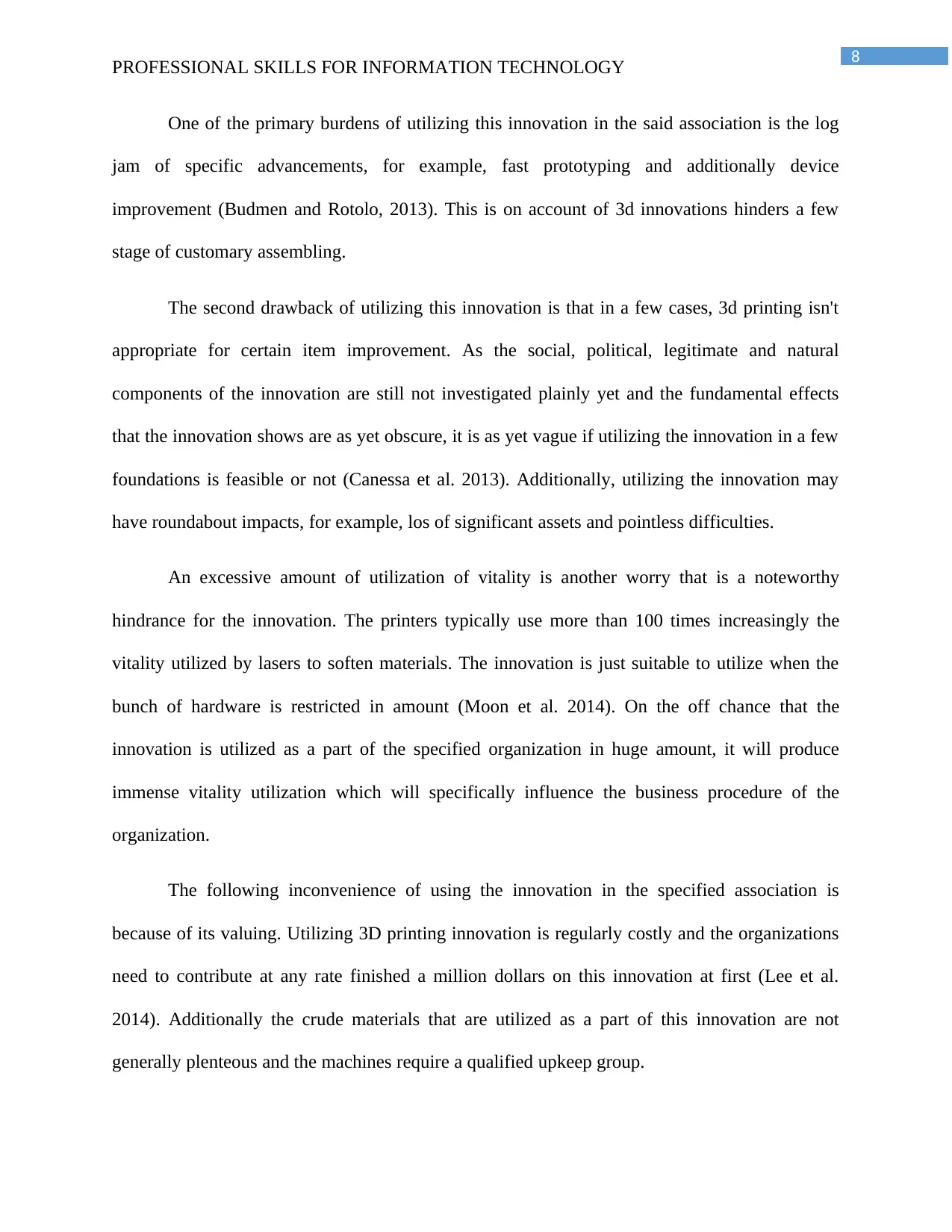
8
PROFESSIONAL SKILLS FOR INFORMATION TECHNOLOGY
One of the primary burdens of utilizing this innovation in the said association is the log
jam of specific advancements, for example, fast prototyping and additionally device
improvement (Budmen and Rotolo, 2013). This is on account of 3d innovations hinders a few
stage of customary assembling.
The second drawback of utilizing this innovation is that in a few cases, 3d printing isn't
appropriate for certain item improvement. As the social, political, legitimate and natural
components of the innovation are still not investigated plainly yet and the fundamental effects
that the innovation shows are as yet obscure, it is as yet vague if utilizing the innovation in a few
foundations is feasible or not (Canessa et al. 2013). Additionally, utilizing the innovation may
have roundabout impacts, for example, los of significant assets and pointless difficulties.
An excessive amount of utilization of vitality is another worry that is a noteworthy
hindrance for the innovation. The printers typically use more than 100 times increasingly the
vitality utilized by lasers to soften materials. The innovation is just suitable to utilize when the
bunch of hardware is restricted in amount (Moon et al. 2014). On the off chance that the
innovation is utilized as a part of the specified organization in huge amount, it will produce
immense vitality utilization which will specifically influence the business procedure of the
organization.
The following inconvenience of using the innovation in the specified association is
because of its valuing. Utilizing 3D printing innovation is regularly costly and the organizations
need to contribute at any rate finished a million dollars on this innovation at first (Lee et al.
2014). Additionally the crude materials that are utilized as a part of this innovation are not
generally plenteous and the machines require a qualified upkeep group.
PROFESSIONAL SKILLS FOR INFORMATION TECHNOLOGY
One of the primary burdens of utilizing this innovation in the said association is the log
jam of specific advancements, for example, fast prototyping and additionally device
improvement (Budmen and Rotolo, 2013). This is on account of 3d innovations hinders a few
stage of customary assembling.
The second drawback of utilizing this innovation is that in a few cases, 3d printing isn't
appropriate for certain item improvement. As the social, political, legitimate and natural
components of the innovation are still not investigated plainly yet and the fundamental effects
that the innovation shows are as yet obscure, it is as yet vague if utilizing the innovation in a few
foundations is feasible or not (Canessa et al. 2013). Additionally, utilizing the innovation may
have roundabout impacts, for example, los of significant assets and pointless difficulties.
An excessive amount of utilization of vitality is another worry that is a noteworthy
hindrance for the innovation. The printers typically use more than 100 times increasingly the
vitality utilized by lasers to soften materials. The innovation is just suitable to utilize when the
bunch of hardware is restricted in amount (Moon et al. 2014). On the off chance that the
innovation is utilized as a part of the specified organization in huge amount, it will produce
immense vitality utilization which will specifically influence the business procedure of the
organization.
The following inconvenience of using the innovation in the specified association is
because of its valuing. Utilizing 3D printing innovation is regularly costly and the organizations
need to contribute at any rate finished a million dollars on this innovation at first (Lee et al.
2014). Additionally the crude materials that are utilized as a part of this innovation are not
generally plenteous and the machines require a qualified upkeep group.
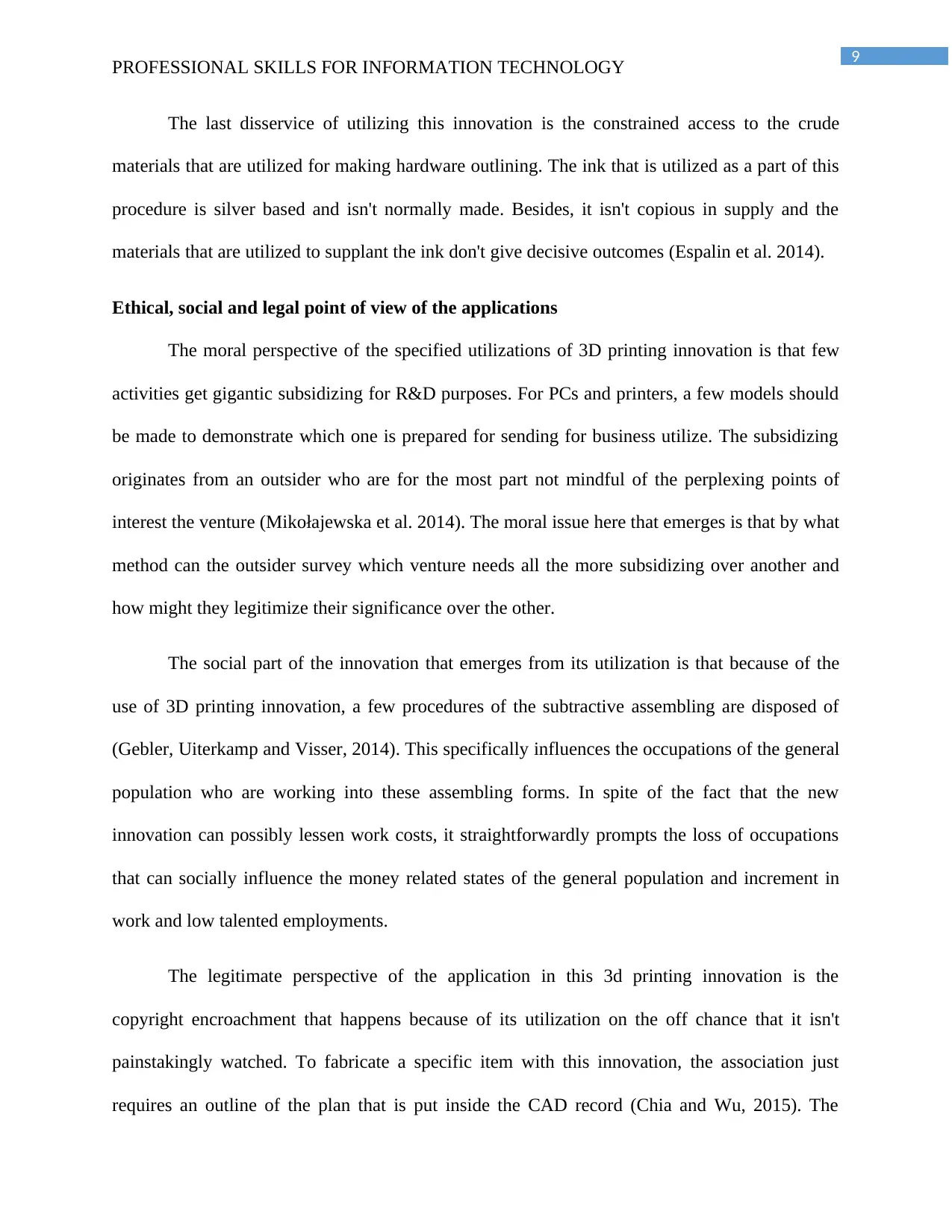
9
PROFESSIONAL SKILLS FOR INFORMATION TECHNOLOGY
The last disservice of utilizing this innovation is the constrained access to the crude
materials that are utilized for making hardware outlining. The ink that is utilized as a part of this
procedure is silver based and isn't normally made. Besides, it isn't copious in supply and the
materials that are utilized to supplant the ink don't give decisive outcomes (Espalin et al. 2014).
Ethical, social and legal point of view of the applications
The moral perspective of the specified utilizations of 3D printing innovation is that few
activities get gigantic subsidizing for R&D purposes. For PCs and printers, a few models should
be made to demonstrate which one is prepared for sending for business utilize. The subsidizing
originates from an outsider who are for the most part not mindful of the perplexing points of
interest the venture (Mikołajewska et al. 2014). The moral issue here that emerges is that by what
method can the outsider survey which venture needs all the more subsidizing over another and
how might they legitimize their significance over the other.
The social part of the innovation that emerges from its utilization is that because of the
use of 3D printing innovation, a few procedures of the subtractive assembling are disposed of
(Gebler, Uiterkamp and Visser, 2014). This specifically influences the occupations of the general
population who are working into these assembling forms. In spite of the fact that the new
innovation can possibly lessen work costs, it straightforwardly prompts the loss of occupations
that can socially influence the money related states of the general population and increment in
work and low talented employments.
The legitimate perspective of the application in this 3d printing innovation is the
copyright encroachment that happens because of its utilization on the off chance that it isn't
painstakingly watched. To fabricate a specific item with this innovation, the association just
requires an outline of the plan that is put inside the CAD record (Chia and Wu, 2015). The
PROFESSIONAL SKILLS FOR INFORMATION TECHNOLOGY
The last disservice of utilizing this innovation is the constrained access to the crude
materials that are utilized for making hardware outlining. The ink that is utilized as a part of this
procedure is silver based and isn't normally made. Besides, it isn't copious in supply and the
materials that are utilized to supplant the ink don't give decisive outcomes (Espalin et al. 2014).
Ethical, social and legal point of view of the applications
The moral perspective of the specified utilizations of 3D printing innovation is that few
activities get gigantic subsidizing for R&D purposes. For PCs and printers, a few models should
be made to demonstrate which one is prepared for sending for business utilize. The subsidizing
originates from an outsider who are for the most part not mindful of the perplexing points of
interest the venture (Mikołajewska et al. 2014). The moral issue here that emerges is that by what
method can the outsider survey which venture needs all the more subsidizing over another and
how might they legitimize their significance over the other.
The social part of the innovation that emerges from its utilization is that because of the
use of 3D printing innovation, a few procedures of the subtractive assembling are disposed of
(Gebler, Uiterkamp and Visser, 2014). This specifically influences the occupations of the general
population who are working into these assembling forms. In spite of the fact that the new
innovation can possibly lessen work costs, it straightforwardly prompts the loss of occupations
that can socially influence the money related states of the general population and increment in
work and low talented employments.
The legitimate perspective of the application in this 3d printing innovation is the
copyright encroachment that happens because of its utilization on the off chance that it isn't
painstakingly watched. To fabricate a specific item with this innovation, the association just
requires an outline of the plan that is put inside the CAD record (Chia and Wu, 2015). The
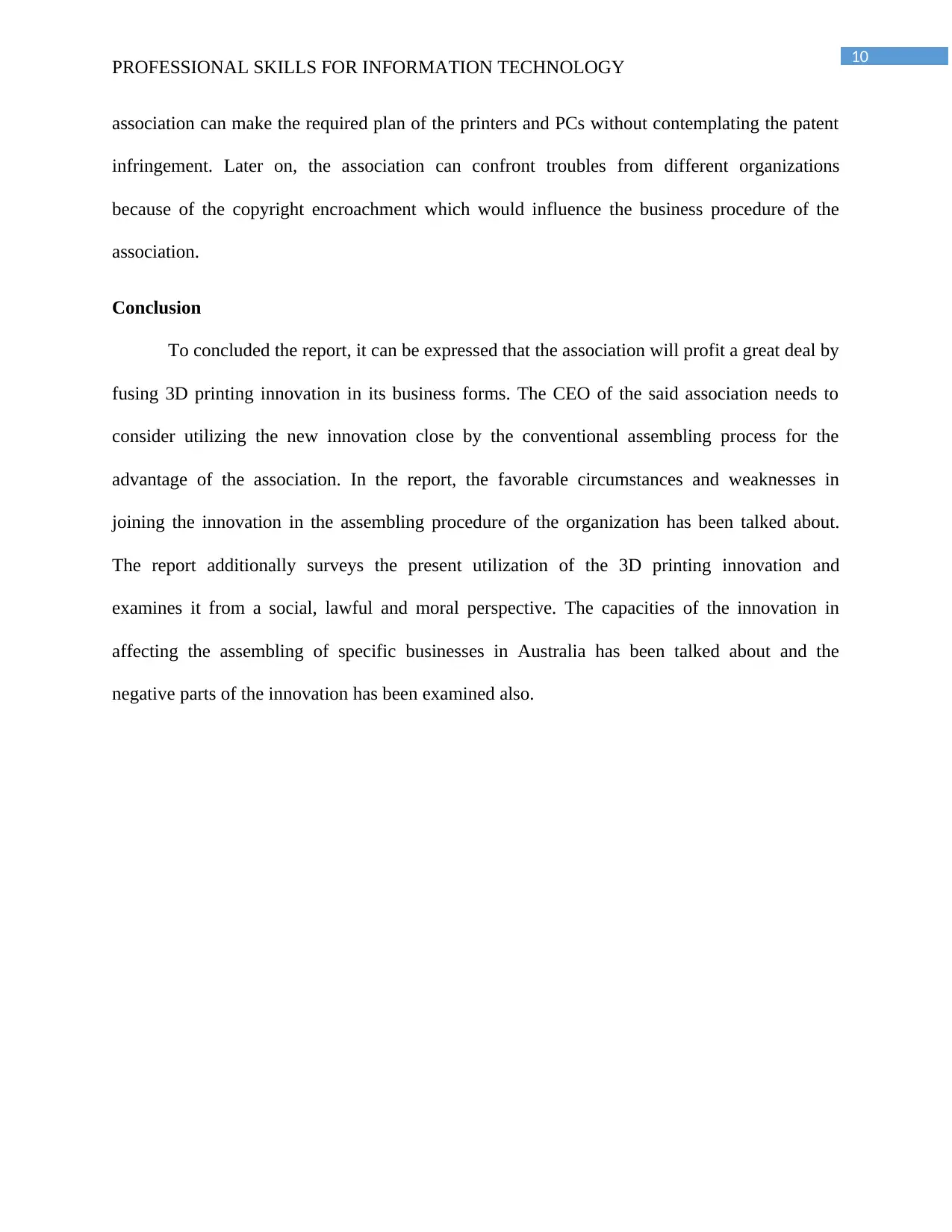
10
PROFESSIONAL SKILLS FOR INFORMATION TECHNOLOGY
association can make the required plan of the printers and PCs without contemplating the patent
infringement. Later on, the association can confront troubles from different organizations
because of the copyright encroachment which would influence the business procedure of the
association.
Conclusion
To concluded the report, it can be expressed that the association will profit a great deal by
fusing 3D printing innovation in its business forms. The CEO of the said association needs to
consider utilizing the new innovation close by the conventional assembling process for the
advantage of the association. In the report, the favorable circumstances and weaknesses in
joining the innovation in the assembling procedure of the organization has been talked about.
The report additionally surveys the present utilization of the 3D printing innovation and
examines it from a social, lawful and moral perspective. The capacities of the innovation in
affecting the assembling of specific businesses in Australia has been talked about and the
negative parts of the innovation has been examined also.
PROFESSIONAL SKILLS FOR INFORMATION TECHNOLOGY
association can make the required plan of the printers and PCs without contemplating the patent
infringement. Later on, the association can confront troubles from different organizations
because of the copyright encroachment which would influence the business procedure of the
association.
Conclusion
To concluded the report, it can be expressed that the association will profit a great deal by
fusing 3D printing innovation in its business forms. The CEO of the said association needs to
consider utilizing the new innovation close by the conventional assembling process for the
advantage of the association. In the report, the favorable circumstances and weaknesses in
joining the innovation in the assembling procedure of the organization has been talked about.
The report additionally surveys the present utilization of the 3D printing innovation and
examines it from a social, lawful and moral perspective. The capacities of the innovation in
affecting the assembling of specific businesses in Australia has been talked about and the
negative parts of the innovation has been examined also.
Secure Best Marks with AI Grader
Need help grading? Try our AI Grader for instant feedback on your assignments.
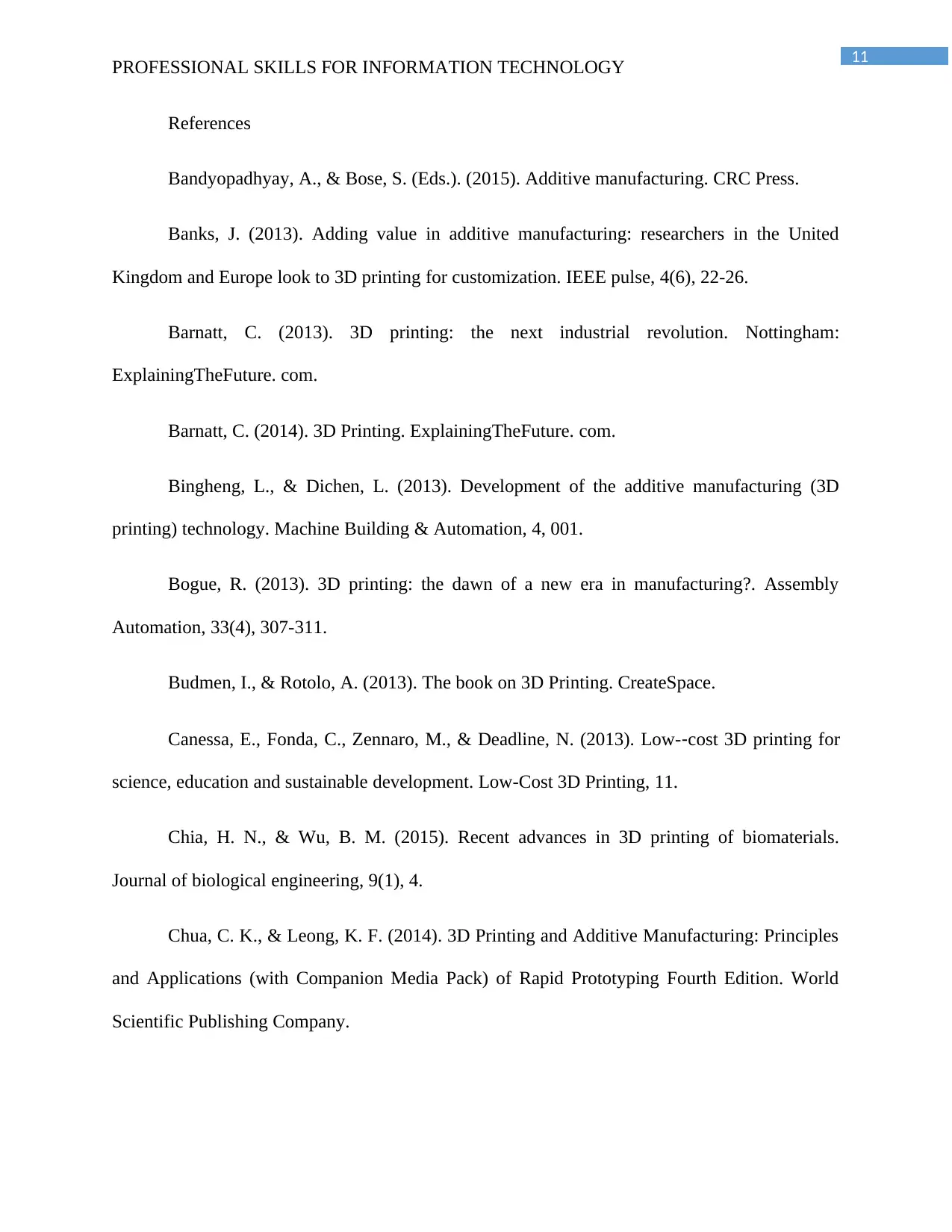
11
PROFESSIONAL SKILLS FOR INFORMATION TECHNOLOGY
References
Bandyopadhyay, A., & Bose, S. (Eds.). (2015). Additive manufacturing. CRC Press.
Banks, J. (2013). Adding value in additive manufacturing: researchers in the United
Kingdom and Europe look to 3D printing for customization. IEEE pulse, 4(6), 22-26.
Barnatt, C. (2013). 3D printing: the next industrial revolution. Nottingham:
ExplainingTheFuture. com.
Barnatt, C. (2014). 3D Printing. ExplainingTheFuture. com.
Bingheng, L., & Dichen, L. (2013). Development of the additive manufacturing (3D
printing) technology. Machine Building & Automation, 4, 001.
Bogue, R. (2013). 3D printing: the dawn of a new era in manufacturing?. Assembly
Automation, 33(4), 307-311.
Budmen, I., & Rotolo, A. (2013). The book on 3D Printing. CreateSpace.
Canessa, E., Fonda, C., Zennaro, M., & Deadline, N. (2013). Low-‐cost 3D printing for
science, education and sustainable development. Low-Cost 3D Printing, 11.
Chia, H. N., & Wu, B. M. (2015). Recent advances in 3D printing of biomaterials.
Journal of biological engineering, 9(1), 4.
Chua, C. K., & Leong, K. F. (2014). 3D Printing and Additive Manufacturing: Principles
and Applications (with Companion Media Pack) of Rapid Prototyping Fourth Edition. World
Scientific Publishing Company.
PROFESSIONAL SKILLS FOR INFORMATION TECHNOLOGY
References
Bandyopadhyay, A., & Bose, S. (Eds.). (2015). Additive manufacturing. CRC Press.
Banks, J. (2013). Adding value in additive manufacturing: researchers in the United
Kingdom and Europe look to 3D printing for customization. IEEE pulse, 4(6), 22-26.
Barnatt, C. (2013). 3D printing: the next industrial revolution. Nottingham:
ExplainingTheFuture. com.
Barnatt, C. (2014). 3D Printing. ExplainingTheFuture. com.
Bingheng, L., & Dichen, L. (2013). Development of the additive manufacturing (3D
printing) technology. Machine Building & Automation, 4, 001.
Bogue, R. (2013). 3D printing: the dawn of a new era in manufacturing?. Assembly
Automation, 33(4), 307-311.
Budmen, I., & Rotolo, A. (2013). The book on 3D Printing. CreateSpace.
Canessa, E., Fonda, C., Zennaro, M., & Deadline, N. (2013). Low-‐cost 3D printing for
science, education and sustainable development. Low-Cost 3D Printing, 11.
Chia, H. N., & Wu, B. M. (2015). Recent advances in 3D printing of biomaterials.
Journal of biological engineering, 9(1), 4.
Chua, C. K., & Leong, K. F. (2014). 3D Printing and Additive Manufacturing: Principles
and Applications (with Companion Media Pack) of Rapid Prototyping Fourth Edition. World
Scientific Publishing Company.
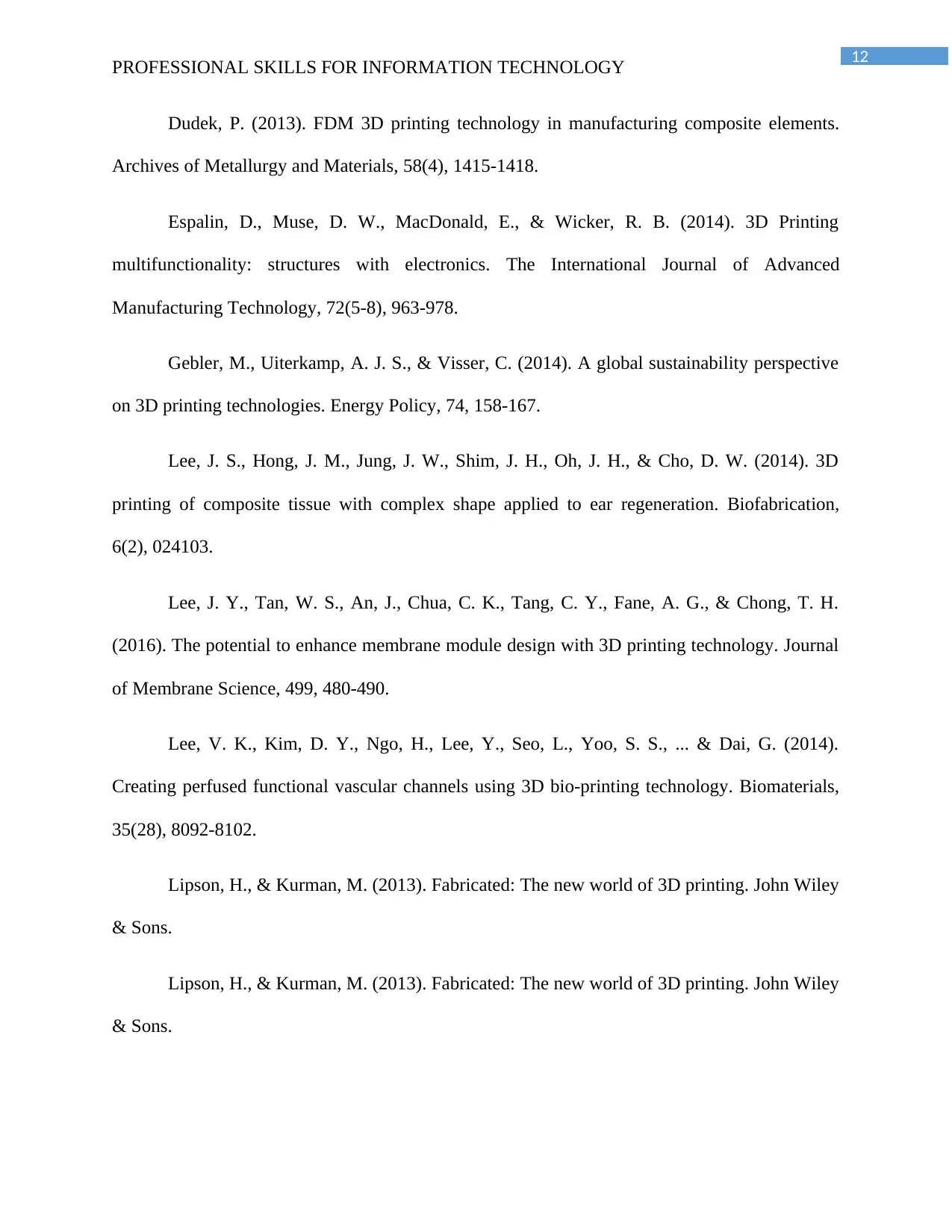
12
PROFESSIONAL SKILLS FOR INFORMATION TECHNOLOGY
Dudek, P. (2013). FDM 3D printing technology in manufacturing composite elements.
Archives of Metallurgy and Materials, 58(4), 1415-1418.
Espalin, D., Muse, D. W., MacDonald, E., & Wicker, R. B. (2014). 3D Printing
multifunctionality: structures with electronics. The International Journal of Advanced
Manufacturing Technology, 72(5-8), 963-978.
Gebler, M., Uiterkamp, A. J. S., & Visser, C. (2014). A global sustainability perspective
on 3D printing technologies. Energy Policy, 74, 158-167.
Lee, J. S., Hong, J. M., Jung, J. W., Shim, J. H., Oh, J. H., & Cho, D. W. (2014). 3D
printing of composite tissue with complex shape applied to ear regeneration. Biofabrication,
6(2), 024103.
Lee, J. Y., Tan, W. S., An, J., Chua, C. K., Tang, C. Y., Fane, A. G., & Chong, T. H.
(2016). The potential to enhance membrane module design with 3D printing technology. Journal
of Membrane Science, 499, 480-490.
Lee, V. K., Kim, D. Y., Ngo, H., Lee, Y., Seo, L., Yoo, S. S., ... & Dai, G. (2014).
Creating perfused functional vascular channels using 3D bio-printing technology. Biomaterials,
35(28), 8092-8102.
Lipson, H., & Kurman, M. (2013). Fabricated: The new world of 3D printing. John Wiley
& Sons.
Lipson, H., & Kurman, M. (2013). Fabricated: The new world of 3D printing. John Wiley
& Sons.
PROFESSIONAL SKILLS FOR INFORMATION TECHNOLOGY
Dudek, P. (2013). FDM 3D printing technology in manufacturing composite elements.
Archives of Metallurgy and Materials, 58(4), 1415-1418.
Espalin, D., Muse, D. W., MacDonald, E., & Wicker, R. B. (2014). 3D Printing
multifunctionality: structures with electronics. The International Journal of Advanced
Manufacturing Technology, 72(5-8), 963-978.
Gebler, M., Uiterkamp, A. J. S., & Visser, C. (2014). A global sustainability perspective
on 3D printing technologies. Energy Policy, 74, 158-167.
Lee, J. S., Hong, J. M., Jung, J. W., Shim, J. H., Oh, J. H., & Cho, D. W. (2014). 3D
printing of composite tissue with complex shape applied to ear regeneration. Biofabrication,
6(2), 024103.
Lee, J. Y., Tan, W. S., An, J., Chua, C. K., Tang, C. Y., Fane, A. G., & Chong, T. H.
(2016). The potential to enhance membrane module design with 3D printing technology. Journal
of Membrane Science, 499, 480-490.
Lee, V. K., Kim, D. Y., Ngo, H., Lee, Y., Seo, L., Yoo, S. S., ... & Dai, G. (2014).
Creating perfused functional vascular channels using 3D bio-printing technology. Biomaterials,
35(28), 8092-8102.
Lipson, H., & Kurman, M. (2013). Fabricated: The new world of 3D printing. John Wiley
& Sons.
Lipson, H., & Kurman, M. (2013). Fabricated: The new world of 3D printing. John Wiley
& Sons.
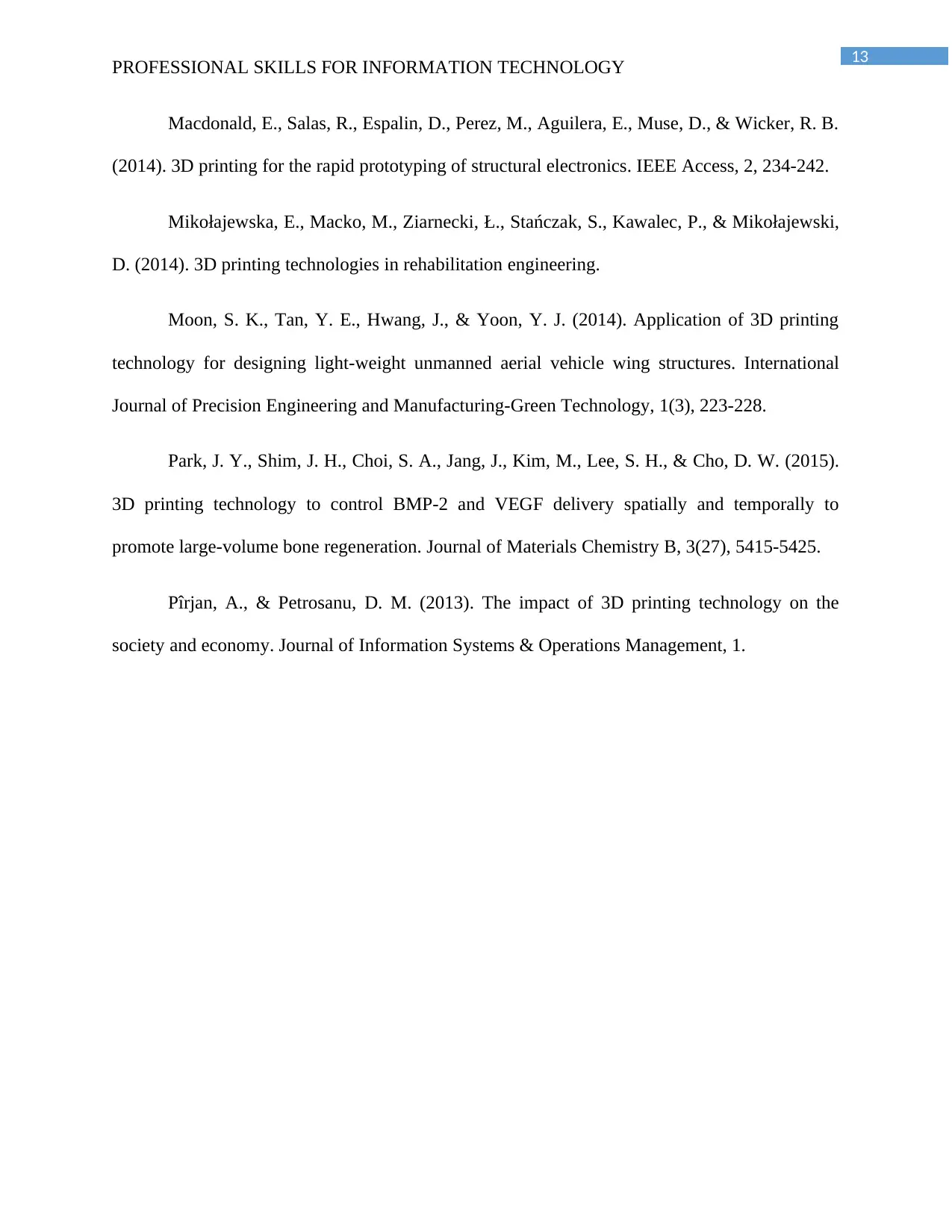
13
PROFESSIONAL SKILLS FOR INFORMATION TECHNOLOGY
Macdonald, E., Salas, R., Espalin, D., Perez, M., Aguilera, E., Muse, D., & Wicker, R. B.
(2014). 3D printing for the rapid prototyping of structural electronics. IEEE Access, 2, 234-242.
Mikołajewska, E., Macko, M., Ziarnecki, Ł., Stańczak, S., Kawalec, P., & Mikołajewski,
D. (2014). 3D printing technologies in rehabilitation engineering.
Moon, S. K., Tan, Y. E., Hwang, J., & Yoon, Y. J. (2014). Application of 3D printing
technology for designing light-weight unmanned aerial vehicle wing structures. International
Journal of Precision Engineering and Manufacturing-Green Technology, 1(3), 223-228.
Park, J. Y., Shim, J. H., Choi, S. A., Jang, J., Kim, M., Lee, S. H., & Cho, D. W. (2015).
3D printing technology to control BMP-2 and VEGF delivery spatially and temporally to
promote large-volume bone regeneration. Journal of Materials Chemistry B, 3(27), 5415-5425.
Pîrjan, A., & Petrosanu, D. M. (2013). The impact of 3D printing technology on the
society and economy. Journal of Information Systems & Operations Management, 1.
PROFESSIONAL SKILLS FOR INFORMATION TECHNOLOGY
Macdonald, E., Salas, R., Espalin, D., Perez, M., Aguilera, E., Muse, D., & Wicker, R. B.
(2014). 3D printing for the rapid prototyping of structural electronics. IEEE Access, 2, 234-242.
Mikołajewska, E., Macko, M., Ziarnecki, Ł., Stańczak, S., Kawalec, P., & Mikołajewski,
D. (2014). 3D printing technologies in rehabilitation engineering.
Moon, S. K., Tan, Y. E., Hwang, J., & Yoon, Y. J. (2014). Application of 3D printing
technology for designing light-weight unmanned aerial vehicle wing structures. International
Journal of Precision Engineering and Manufacturing-Green Technology, 1(3), 223-228.
Park, J. Y., Shim, J. H., Choi, S. A., Jang, J., Kim, M., Lee, S. H., & Cho, D. W. (2015).
3D printing technology to control BMP-2 and VEGF delivery spatially and temporally to
promote large-volume bone regeneration. Journal of Materials Chemistry B, 3(27), 5415-5425.
Pîrjan, A., & Petrosanu, D. M. (2013). The impact of 3D printing technology on the
society and economy. Journal of Information Systems & Operations Management, 1.
1 out of 13
Related Documents
Your All-in-One AI-Powered Toolkit for Academic Success.
+13062052269
info@desklib.com
Available 24*7 on WhatsApp / Email
![[object Object]](/_next/static/media/star-bottom.7253800d.svg)
Unlock your academic potential
© 2024 | Zucol Services PVT LTD | All rights reserved.



